 |
|
 |
|
 |
|
 |
|
 |
|
 |
|
 |
|
 |
|
 |
|
 |
|
 |
|
 |
|
 |
|
 |
|
 |
|
Cryptocurrency News Articles
Decoding the Business Model of Ethereum: From GAS Fees to Burned Tokens
Apr 02, 2025 at 11:42 pm
In traditional investment fields and venture capital, the business model is one of the key factors that investors examine when looking at a company or project.

In traditional investment fields and venture capital, the business model is one of the key factors that investors examine when looking at a company or project.
However, in the crypto industry ecosystem, investors seem less enthusiastic about discussing this factor. But I believe we must return to normal logic and common sense; aside from Bitcoin and similar collectibles, the business model of all other projects should be discussed.
Let’s start with Ethereum.
To understand what Ethereum's business model is, we need to look at how Ethereum operates, what services it provides to users, and what its sources of income are.
As a layer-1 blockchain, Ethereum provides services that support the deployment, operation, and transfer of upper-layer applications (smart contracts) and users (wallets). Its source of income comes from the GAS fees paid by these applications and users for these actions (transactions).
The GAS fees it receives can be further divided into two categories: one is the tips given to miners, and the other is the burned GAS.
The tips given to miners can be seen as Ethereum's expenditure to maintain the system.
At the same time, Ethereum also issues new tokens each year to reward miners for mining. I also consider this part as an expenditure.
The burned GAS, on the other hand, provides meaningful income back to all Ethereum token holders. This income can be seen as being used for token buybacks and destruction, benefiting all token holders.
Therefore, the total burned tokens minus all newly issued tokens gives us Ethereum's truly effective "net profit."
This is Ethereum's business model.
On Etherscan (https://etherscan.io/chart/dailyethburnt), you can check the daily burning amount of Ethereum. After the implementation of EIP-1559 in August 2021, the daily burning amount during the peak period in 2021 was approximately 10,000 to 20,000 ETH.
On Etherscan (https://etherscan.io/chart/ethersupplygrowth), you can find that Ethereum issued approximately 3 million ETH in 2024, with a daily issuance of about 8,300 ETH.
If we calculate based on a daily burn of 10,000 ETH, the annual income of the Ethereum network during its peak period is 3.65 million ETH. If we calculate based on a daily burn of 20,000 ETH, the annual income of the Ethereum network during its peak period is 7.3 million ETH.
Subtracting the amount of newly issued tokens from the total burned amount, we find that Ethereum's peak annual "net profit" is approximately 650,000 ETH to 4.3 million ETH.
Based on the average price of Ethereum in 2021 being around $2,000, its annual net profit would be $1.3 billion to $8.6 billion.
Let’s compare this maximum value of $8.6 billion with Alibaba, which is also a platform :
Alibaba's latest annual report shows that its net profit for 2024 is approximately $21 billion.
It can be seen that Ethereum's maximum annualized net profit during its peak period is close to half of Alibaba's.
In the peak profit year of 2021, Ethereum's price was around $2,000 to $4,000, with a corresponding market capitalization of approximately $200 billion to $500 billion.
Thus, Ethereum's maximum market capitalization that year was $500 billion, while Alibaba's current market capitalization is $300 billion ; however, Ethereum's maximum annualized net profit that year was less than half of Alibaba's.
From this perspective, it appears that Ethereum's market capitalization at that time was overvalued, but not as absurdly overvalued as we might subconsciously think.
Overall, it seems that traditional valuation methods are also applicable in the crypto ecosystem.
Let’s further imagine that if Ethereum's ecosystem flourishes again in the future and reaches the scale of Amazon today, we can roughly estimate its corresponding market capitalization.
Amazon's net profit for 2024 is $59.2 billion, and its current market capitalization is $2 trillion.
If Ethereum can reach this level, its corresponding unit price would be approximately $17,000, with a daily "net profit" of about 9,500 ETH, corresponding to a daily burn of approximately 18,000 ETH (assuming the issuance rate of Ethereum remains unchanged).
It is important to note that this 18,000 ETH is the average daily burn ; in real daily situations, I estimate the actual daily burn of ETH to be between 15,
Disclaimer:info@kdj.com
The information provided is not trading advice. kdj.com does not assume any responsibility for any investments made based on the information provided in this article. Cryptocurrencies are highly volatile and it is highly recommended that you invest with caution after thorough research!
If you believe that the content used on this website infringes your copyright, please contact us immediately (info@kdj.com) and we will delete it promptly.
-

-

-

- Trapped in a Falling Wedge, VeChain (VET) Signals a Potential Touchpoint at $0.018 Despite the Network’s Fresh Recovery in Q1 2025
- Apr 03, 2025 at 10:00 pm
- With the US President signing an executive order to initiate tariff wars, global economic uncertainty has caused a 3.49% pullback in the crypto market.
-

-

-

-

-

-





























































